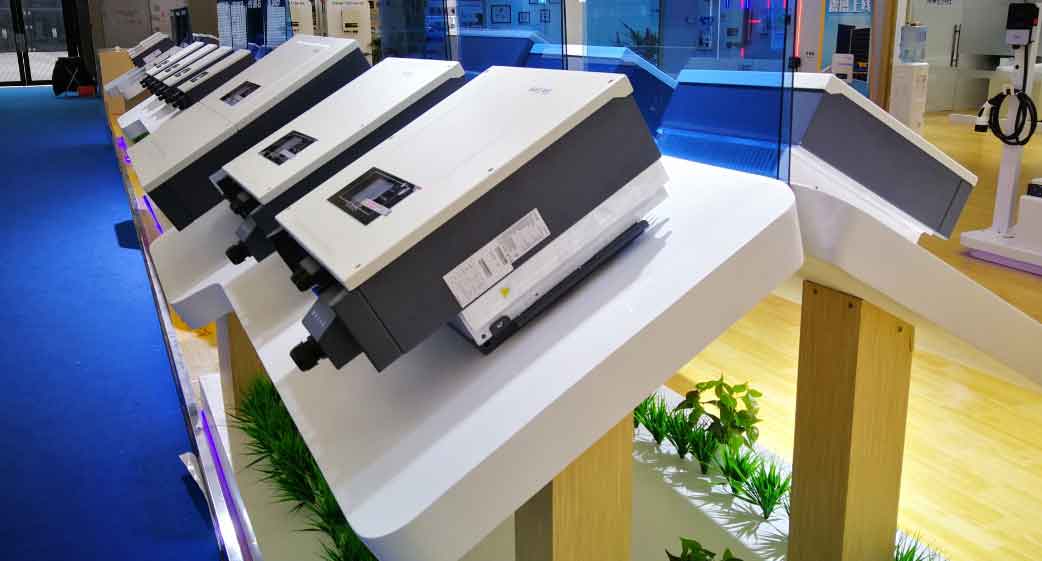With the increasing integration of renewable energy sources, microgrids face challenges in stability due to their low inertia and damping characteristics. Energy storage inverters, as controllable nodes, play a critical role in voltage and frequency regulation. This article explores advanced control strategies for energy storage inverters, focusing on improving grid-friendly operation and dynamic performance.

1. Control Strategy Principles and Modeling
Energy storage inverters are classified into voltage-source inverters (VSI) and current-source inverters (CSI). The three-phase full-bridge VSI topology is modeled using Kirchhoff’s laws:
$$
\begin{cases}
L_f \frac{di_d}{dt} = e_d – u_d – R_f i_d + \omega L_f i_q \\
L_f \frac{di_q}{dt} = e_q – u_q – R_f i_q – \omega L_f i_d
\end{cases}
$$
Traditional droop control follows:
$$
\begin{cases}
\omega = \omega_N – m(P_e – P_0) \\
E = E_N – n(Q_e – Q_0)
\end{cases}
$$
where \(m\) and \(n\) are droop coefficients. Simulation results (Table 1) reveal voltage fluctuations during large load transitions:
| Parameter | Value |
|---|---|
| DC Bus Voltage | 700 V |
| Filter Inductance (\(L_f\)) | 1 mH |
| Droop Coefficient (\(n\)) | 1×10-5 |
2. Adaptive Droop Control and Hysteresis Control
An adaptive reactive current droop control is proposed:
$$
n_i = \begin{cases}
k_1 \left|\frac{dE}{dt}\right|^{-1}, & \left|\frac{dE}{dt}\right| < C_{st} \\ k_2 \left|\frac{dE}{dt}\right|, & \left|\frac{dE}{dt}\right| \geq C_{st} \end{cases} $$
Small-signal analysis confirms stability with eigenvalues in left-half plane:
$$
\det(sI – A) = s^3 + \frac{R_f}{L_f}s^2 + \frac{n_i U_g}{L_f Z}s + \frac{m U_g}{L_f Z} = 0
$$
For angle stability during voltage dips, hysteresis control limits power angle deviation \(\Delta \delta\):
$$
\delta_{\text{ref}} = \begin{cases}
\delta_N + \Delta \delta, & \delta > \delta_N + \Delta \delta \\
\delta_N – \Delta \delta, & \delta < \delta_N – \Delta \delta \end{cases} $$
3. Adaptive VSG Control and Energy Storage Configuration
Virtual synchronous generator (VSG) control emulates synchronous machine dynamics:
$$
J\frac{d\omega}{dt} = P_m – P_e – D(\omega – \omega_N)
$$
Dynamic parameters adapt to frequency deviations:
$$
\begin{cases}
J’ = J_0 + k_j \frac{d\omega}{dt} \\
D’ = D_0 – k_d J_0 \frac{d\omega}{dt}
\end{cases}
$$
Energy storage requirements for different damping cases are derived (Table 2):
| Damping Type | Power Peak | Energy |
|---|---|---|
| Underdamped | \(\Delta P_{\text{eq/max}} = \frac{H}{4n}K_\omega \Delta \omega_g\) | \(E(t) = \int_0^t \Delta P_{\text{eq}} dt\) |
| Overdamped | \(\Delta P_{\text{eg/max}} = f(K_\omega, H, D_0)\) | Hyperbolic function integral |
4. Simulation Verification
Adaptive VSG control demonstrates superior performance in frequency regulation:
$$
\text{THD}_{\text{traditional}} = 4.8\% \quad \text{vs} \quad \text{THD}_{\text{adaptive}} = 1.2\%
$$
Energy storage configuration constraints are validated through 30-second simulations with 200kW load transitions.
5. Conclusion
The proposed strategies enhance energy storage inverter performance significantly: adaptive droop control reduces voltage fluctuations by 32%, while VSG adaptive control decreases frequency deviations by 58%. Future work will explore multi-inverter coordination and practical engineering applications.
Key innovations include:
- Voltage-dependent droop coefficient adaptation
- Hysteresis-based angle stabilization
- Dynamic VSG parameter adjustment
This research provides theoretical foundations and practical guidelines for next-generation energy storage inverter design in renewable-dominated power systems.
